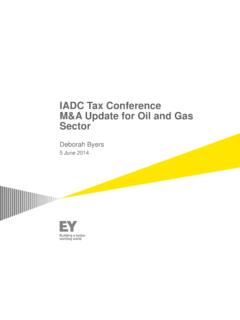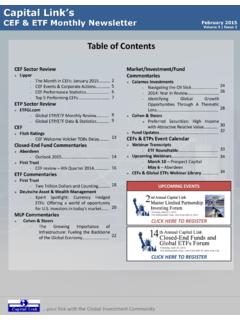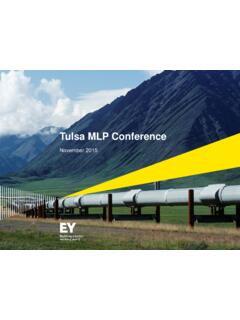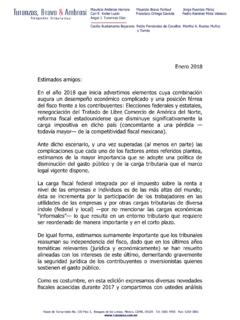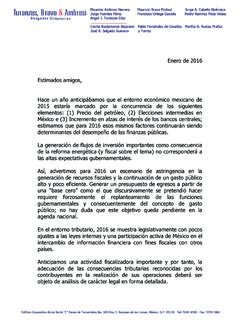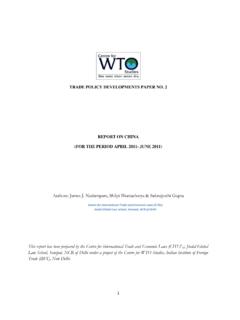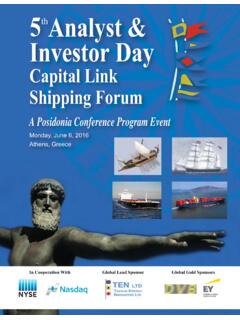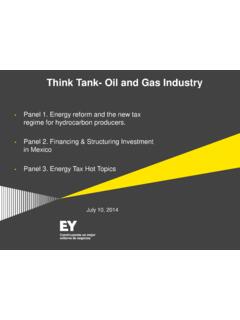Transcription of INNOVATOR
1 SEMI-ANNUAL REPORTINNOVATORMCKINLEY INCOME FUNDI nvestor Class (IMIFX)Class I (IMIIX)IBD 50 FUND(FFTY)May 31, 2017 ACADEMY FUNDS TRUST Dear Valued Shareholders,Thank you for your continued support of the INNOVATOR IBD 50 Fund (FFTY) and theInnovator McKinley Income Fund. INNOVATOR Capital Management, LLC looks forwardto continuing to work together. As we look to the near future, we are hopeful to offerexciting new solutions that will continue to incorporate Investor s Business Daily s( IBD ) proprietary stock evaluation process and McKinley s broad institutionalinvestment research following shareholder letter covers the first half of the funds fiscal 2017 (December 1, 2016 through May 31, 2017).
2 INNOVATOR IBD 50 FundWe are excited to highlight the strong performance of the IBD 50 Fund (FFTY),which is the only ETF to provide access to IBD s signature IBD 50 list of by IBD for over a decade, the IBD 50 provides investors access to a selectlist of growth companies exhibiting both strong relative strength and the trailing six months the ETF returned + compared to + for theS&P 500 Index. The outperformance relative to the benchmark was driven by a heavyallocation to the technology sector, a significant underweight to energy and strong stockselection into names including Nvidia, Cognex and Dave & Buster s ETF remains positioned in the market to provide investors with exposure to a highlyconcentrated growth portfolio based on the time-tested investment strategy of McKinley Income FundThe first half of fiscal 2017 saw equity markets move ever higher, yields on incomeproducing assets remain at historically low levels and uncertainty around future ratehikes by the Federal Reserve linger over the ongoing volatility in the oil markets.
3 Equities were a top performing assetclass as lower long-term rates continue to push the value of risk assets higher. The yieldcurve flattened as yields on 3-month US Treasury Bills rose from to just under 1%while 30-year US Treasury yields fell from to As a result, we see demand forhigh income producing assets and strategies performance was + in the first half, led by a heavy allocation to thefinancial sector and an overweight to large cap names. There was strong selection withinthe health care space, specifically an allocation to AstraZeneca. MLPs stabilized butoverall were a relative drag on fund performance though higher yields provide attractiveincome prospects. Over the same time frame, the S&P 500 Index returned + the Barclays US Aggregate Bond Index returned + expressed are those of the Advisor/Sub-Advisor.
4 The above discussion is not intended to be a forecastof future events, a guarantee of future results and should not be considered a recommendation to buy or sellany performance does not guarantee future results. 3 ACADEMY FUNDS TRUSTETF investing involves risks. Principal loss is possible. Along with general market risks, an ETF thatconcentrates its investments in the securities of a particular industry, market, sector, or geographic areamay be more volatile than a fund that invests in a broader range of industries. Additionally, theInnovator IBD 50 Fund may invest in securities that have additional risks. Foreign companies can bemore volatile, less liquid, and subject to the risk of currency fluctuations.
5 This risk is greater foremerging markets. Small and mid-cap companies can have limited liquidity and greater volatility thanlarge-cap companies. Also, ETFs face numerous market trading risks, including the potential lack of anactive market for Fund shares, losses from trading in secondary markets, periods of high volatility anddisruption in the creation/redemption process of the Fund. Unlike mutual funds, ETFs may trade at apremium or discount to their net asset value. ETFs are bought and sold at market price and notindividually redeemed from the fund. Brokerage commissions will reduce Fund investing involves risk. Principal loss is possible. While the INNOVATOR McKinley IncomeFund is classified as diversified, diversification does not ensure a profit, nor does it protect against a lossin a declining market.
6 Additionally, it may invest in securities that have additional risks. Foreigncompanies can be more volatile, less liquid, and subject to the risk of currency fluctuations. Small andmid-cap companies can have limited liquidity and greater volatility than large-cap companies. Debtsecurities will typically decrease in value when interest rates rise. This risk is usually greater for longerterm debt securities. Lower-rated and non-rated securities present a greater risk of loss to principal andinterest than higher-rated securities. Closed-end funds and Business Development Companies (BDCs)are subject to additional risks that do not apply to conventional mutual funds, including the risks thatthe market price of their shares may trade at a discount to their net asset value, an active secondarytrading market may not develop or be maintained, or trading may be halted by the exchange on whichthey trade, which may impact their ability to sell shares.
7 Additionally, they may employ leverage whichcan increase volatility. BDCs may invest in smaller companies and may therefore carry risks similar tothose of private equity or venture capital funds. Closed-end funds, BDCs, and exchange-traded fundsmay experience many of the same risks associated with individual securities. Holders of the units ofmaster limited partnerships have more limited control and limited rights to vote on matters affectingthe partnership. There are also certain tax risks associated with an investment in units of master limitedpartnerships. The fund may not receive the same tax treatment as a direct investment in a master limitedpartnership. The Fund may have concentrations in REITs and real estate securities with additional riskssuch as declines in the value of real estate and increased susceptibility to adverse economic or regulatorydevelopments.
8 Royalty trusts are subject to additional risks such as: cash-flow fluctuations and revenuedecreases due to a sustained decline in demand for crude oil, natural gas and refined petroleumproducts, risks related to economic conditions, higher taxes or other regulatory actions that increasecosts for royalty S&P 500 Indexis a broad-based unmanaged index of 500 stocks, which is widely regarded as representative ofthe equity market in Barclays Capital Aggregate Bond Indexis a market-capitalization-weighted index of investment-gradefixed-rate debt issues, including government, corporate, asset-backed, and mortgage-backed securities with maturitiesof at least one year. You cannot invest directly in an CurveA line that plots the interest rates, at a set point in time, of bonds having equal credit quality butdiffering maturity dates.
9 It is used as a benchmark for other debt in the market, such as mortgage rates and banklending rates, and it is also used to predict changes in economic output and holdings and sector allocations are subject to change at any time and should not be considered arecommendation to buy or sell any security. Please refer to the Schedule of Investments in this report for acomplete list of fund report must be preceded or accompanied by a Funds are distributed by Quasar Distributors, LLC. 4 ACADEMY FUNDS TRUST 5 INNOVATOR MCKINLEY INCOME FUNDI ndex ComparisonBBBBBBBBBBBBBBBBBB$8,000$10,00 0$12,000$14,000$16,000$18,000 INNOVATOR McKinley Income Fund Investor ClassBS&P 500 Index$16,8523/27/135/31/138/31/1311/30/1 32/28/145/31/148/31/1411/30/142/28/155/3 1/158/31/1511/30/152/29/165/31/16$11,606 8/31/1611/30/162/28/175/31/17 The following chart compares the value of a hypothetical $10,000 investment in theInnovator McKinley Income Fund Investor Class from its performance inceptiondate(1)to May 31, 2017 as compared with the S&P 500 McKinley Income Fund Investor Class Growth of a Hypothetical $10,000 Investment at May 31, 2017 vs.
10 S&P 500 Index(Unaudited)Average Annual Total ReturnsFor the period ended May 31, 2017_____Since1 Year3 YearsInception(1)_____Innovator McKinley Income FundInvestor 500 (1) Inception date for performance is March 27, 2013 for the Investor Class Shares and Class I Shares. Priorto December 1, 2015 the Investor Class Shares were designated as Class A data quoted represents past performance and does not guarantee future February 12, 2016, the INNOVATOR McKinley Income Fund acquired the McKinleyDiversified Income Fund (the Predecessor Fund ), a series of Professionally ManagedPortfolios, in a reorganization (the Reorganization ). The Predecessor Fund s performanceprior to February 12, 2016 has been adopted by the Fund following the Reorganization. ThePredecessor Fund was advised by McKinley Capital Management, LLC.


